Makita LS1214L, LS1214F, LS1214 User Manual
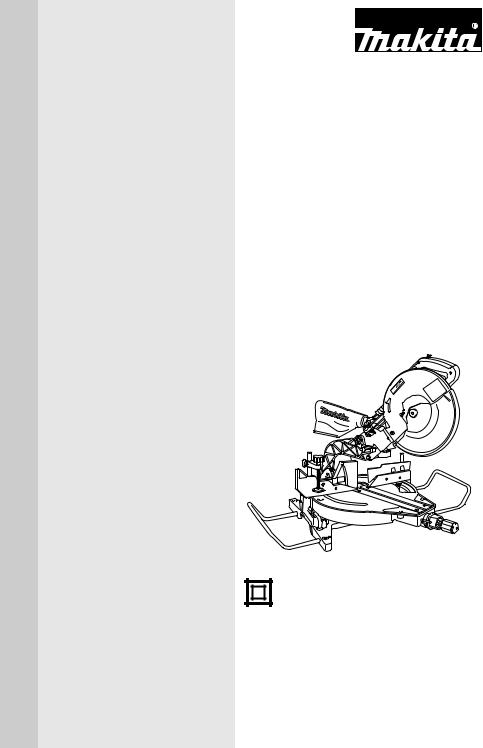
I N S T R U C T I O N M A N U A L
M A N U E L D ' I N S T R U C T I O N
M A N U A L D E I N S T R U C C I O N E S
Slide Compound Saw Scie Multi Coupe
Sierra de Inglete Telescópica
LS1214
LS1214F
LS1214L
005689
DOUBLE INSULATION DOUBLE ISOLATION
DOBLE AISLAMIENTO
 WARNING:
WARNING:
For your personal safety, READ and UNDERSTAND before using. SAVE THESE INSTRUCTIONS FOR FUTURE REFERENCE.
 AVERTISSEMENT:
AVERTISSEMENT:
Pour votre propre sécurité, prière de lire attentivement avant l’utilisation. GARDER CES INSTRUCTIONS POUR RÉFÉRENCE ULTÉRIEURE.
 ADVERTENCIA:
ADVERTENCIA:
Para su seguridad personal, LEA DETENIDAMENTE este manual antes de usar la herramienta. GUARDE ESTAS INSTRUCCIONES PARA FUTURA REFERENCIA.

ENGLISH
SPECIFICATIONS
Model ................................................................................................................................ |
LS1214 / LS1214F / LS1214L |
Blade diameter............................................................................................................................................ |
305 mm (12”) |
Hole diameter............................................................................................................................................... |
25.4 mm (1”) |
Max. Miter angle ................................................................................................................................ |
Left 47° , Right 52° |
Max. Bevel angle.................................................................................................................................. |
Left and Right 45° |
Max. Cutting capacities (H x W)
Miter angle |
|
Bevel angle |
|
||
|
|
|
|
||
|
45° (left) |
0° |
|
45° (right) |
|
|
|
|
|
||
|
*71 mm x 260 mm |
*120 mm x 270 mm |
*50 mm x 260 mm |
||
0° |
(2-13/16” x 10-1/4”) |
(4-3/4” x 10-5/8”) |
(2” x 10-1/4”) |
||
66 mm x 305 mm |
115 mm x |
308 mm |
45 mm x 305 mm |
||
|
|||||
|
(2-5/8” x 12”) |
(4-1/2” x 12-1/8”) |
(1-3/4” x 12”) |
||
|
|
|
|
|
|
|
(left)*71 mm x 155 mm |
|
|
|
|
|
(2-13/16” x 6-1/8”) |
|
|
|
|
|
66 mm x 170 mm |
*120 mm x 185 mm |
*50 mm x 175 mm |
||
45° (left and right) |
(2-5/8” x 6-11/16”) |
(4-3/4” x |
7-1/4”) |
(2” x 6-7/8”) |
|
(right)*71 mm x 175 mm |
115 mm x |
218 mm |
45 mm x 215 mm |
||
|
|||||
|
(2-13/16” x 6-7/8”) |
(4-1/2” x |
8-5/8”) |
(1-3/4” x 8-1/2”) |
|
|
66 mm x 215 mm |
|
|
|
|
|
(2-5/8” x 8-1/2”) |
|
|
|
|
|
|
|
|
||
|
|
*120 mm x 160 mm |
|
||
52° (right) |
- |
(4 - 3/4” x 6 - 5/16”) |
- |
||
115 mm x |
185 mm |
||||
|
|
|
|||
|
|
(4-1/2” x |
7-1/4”) |
|
|
|
|
|
|
|
|
(Note)
* mark indicates that a wood facing with the following thickness is used.
Miter angle |
Thickness of wood |
|
|
|
|
0° |
20 mm (13/16”) |
|
|
|
|
45° (left and right) |
15 mm (9/16”) |
|
|
|
|
52° (right) |
15 mm (9/16”) |
|
|
|
|
No load speed (RPM) ...................................................................................................................................... |
|
3,200/min. |
Laser Type (LS1214L only) ............................................. |
Wavelength 655 nm, Maximum Output < 1mW (Laser class II) |
|
Dimensions (L x W x H) ................................................................. |
|
LS1214/LS1214F…….723 mm x 520 mm x 696 mm |
|
|
(28-1/2” x 20-1/2” x 27-1/2”) |
|
|
LS1214L…….723 mm x 520 mm x 718 mm |
|
|
(28-1/2” x 20-1/2” x 28-1/4”) |
Net weight ............................................................................................................ |
|
LS1214/LS1214F…….23 kg (50.7 lbs) |
|
|
LS1214L…….24 kg (52.9 lbs) |
•Due to our continuing programme of research and development, the specifications herein are subject to change without notice.
•Note: Specifications may differ from country to country.
2

For Your Own Safety Read Instruction Manual Before Operating Tool Save it for future reference GENERAL SAFETY PRECAUTIONS
USA007-2
(For All Tools)
1.KNOW YOUR POWER TOOL. Read the owner’s manual carefully. Learn the tool’s applications and limitations, as well as the specific potential hazards peculiar to it.
2.KEEP GUARDS IN PLACE and in working order.
3.REMOVE ADJUSTING KEYS AND WRENCHES. Form habit of checking to see that keys and adjusting wrenches are removed from tool before turning it on.
4.KEEP WORK AREA CLEAN. Cluttered areas and benches invite accidents.
5.DON’T USE IN DANGEROUS ENVIRONMENT. Don’t use power tools in damp or wet locations, or expose them to rain. Keep work area well lighted. Don’t use tool in presence of flammable liquids or gases.
6.KEEP CHILDREN AWAY. All visitors should be kept safe distance from work area.
7.MAKE WORKSHOP KID PROOF with padlocks, master switches, or by removing starter keys.
8.DON’T FORCE TOOL. It will do the job better and safer at the rate for which it was designed.
9.USE RIGHT TOOL. Don’t force tool or attachment to do a job for which it was not designed.
10.WEAR PROPER APPAREL. Do not wear loose clothing, gloves, neckties, rings, bracelets, or other jewelry which may get caught in moving parts. Nonslip footwear is recommended. Wear protective hair covering to contain long hair.
11.ALWAYS USE SAFETY GLASSES. Also use face or dust mask if cutting operation is dusty. Everyday eyeglasses only have impact resistant lenses, they are NOT safety glasses.
12.SECURE WORK. Use clamps or a vise to hold work when practical. It’s safer than using your hand and it frees both hands to operate tool.
13.DON’T OVERREACH. Keep proper footing and balance at all times.
16.REDUCE THE RISK OF UNINTENTIONAL STARTING. Make sure switch is in off position before plugging in.
17.USE RECOMMENDED ACCESSORIES. Consult the owner’s manual for recommended accessories. The use of improper accessories may cause risk of injury to persons.
18.NEVER STAND ON TOOL. Serious injury could occur if the tool is tipped or if the cutting tool is unintentionally contacted.
19.CHECK DAMAGED PARTS. Before further use of the tool, a guard or other part that is damaged should be carefully checked to determine that it will operate properly and perform its intended function - check for alignment of moving parts, binding of moving parts, breakage of parts, mounting, and any other conditions that may affect its operation. A guard or other part that is damaged should be properly repaired or replaced.
20.DIRECTION OF FEED. Feed work into a blade or cutter against the direction of rotation of the blade or cutter only.
21.NEVER LEAVE TOOL RUNNING UNATTENDED. TURN POWER OFF. Don’t leave tool until it comes to a complete stop.
22.REPLACEMENT PARTS. When servicing use only identical replacement parts.
23.POLARIZED PLUGS. To reduce the risk of electric shock, this equipment has a polarized plug (one blade is wider than the other). This plug will fit in a polarized outlet only one way. If the plug does not fit fully in the outlet, reverse the plug. If it still does not fit, contact a qualified electrician to install the proper outlet. Do not change the plug in any way.
VOLTAGE WARNING: Before connecting the tool to a power source (receptacle, outlet, etc.) be sure the voltage supplied is the same as that specified on the nameplate of the tool. A power source with voltage greater than that specified for the tool can result in SERIOUS INJURY to the user – as well as damage to the tool. If in doubt, DO NOT PLUG IN THE TOOL. Using a power source with voltage less than the nameplate rating is harmful to the motor.
USE PROPER EXTENSION CORD. Make sure your extension cord is in good condition. When using an extension cord, be sure to use one heavy enough to carry the current your product will draw. An undersized cord will cause a drop in line voltage resulting in loss of
14.MAINTAIN TOOLS WITH CARE. Keep tools sharp power and overheating. Table 1 shows the correct size to and clean for best and safest performance. Fol- use depending on cord length and nameplate ampere low instructions for lubricating and changing rating. If in doubt, use the next heavier gage. The smaller
accessories. |
the gage number, the heavier the cord. |
15.DISCONNECT TOOLS before servicing; when changing accessories such as blades, bits, cutters, and the like.
3

Table 1. Minimum gage for cord
Ampere Rating |
Volts |
|
Total length of cord in feet |
|
||||
120 V |
25 ft. |
|
50 ft. |
100 ft. |
|
150 ft. |
||
|
|
|
|
|||||
|
|
|
|
|
|
|
|
|
More Than |
Not More Than |
|
|
|
AWG |
|
|
|
|
|
|
|
|
|
|
|
|
0 |
6 |
|
18 |
|
16 |
16 |
|
14 |
|
|
|
|
|
|
|
|
|
6 |
10 |
|
18 |
|
16 |
14 |
|
12 |
|
|
|
|
|
|
|
|
|
10 |
12 |
|
16 |
|
16 |
14 |
|
12 |
|
|
|
|
|
|
|
|
|
12 |
16 |
|
14 |
|
12 |
Not Recommended |
||
|
|
|
|
|
|
|
|
|
ADDITIONAL SAFETY RULES
USB036-2
DO NOT let comfort or familiarity with product (gained from repeated use) replace strict adherence to slide compound saw safety rules. If you use this tool unsafely or incorrectly, you can suffer serious personal injury.
1.Wear eye protection.
2.Keep hands out of path of saw blade. Avoid contact with any coasting blade. It can still cause severe injury.
12.Check the blade carefully for cracks or damage before operation. Replace cracked or damaged blade immediately. Gum and wood pitch hardened on blades slows saw and increases potential for kickback. Keep blade clean by first removing it from tool, then cleaning it with gum and pitch remover, hot water or kerosene. Never use gasoline to clean blade.
13.While making a slide cut, KICKBACK can occur. KICKBACK occurs when the blade binds in the workpiece during a cutting operation and the saw blade is driven back rapidly towards the operator. Loss of control and serious personal injury can result. If blade begins to bind during a cutting operation, do not continue to cut and release switch immediately.
3.Do not operate saw without guards in place. 14. Use only flanges specified for this tool.
Check blade guard for proper closing before each use. Do not operate saw if blade guard does not move freely and close instantly. Never clamp or tie the blade guard into the open position.
4.Do not perform any operation freehand. The workpiece must be secured firmly against the turn base and guide fence with a vise during all operations. Never use your hand to secure the workpiece.
5.Never reach around saw blade.
6.Turn off tool and wait for saw blade to stop before moving workpiece or changing settings.
7.Unplug tool before changing blade or servicing.
8.To reduce the risk of injury, return carriage to the full rear position after each crosscut operation.
9.Always secure all moving portions before carrying the tool.
10.Stopper pin which locks the cutter head down is for carrying and storage purposes only and not for any cutting operations.
11.Do not use the tool in the presence of flammable liquids or gases.
15.Be careful not to damage the arbor, flanges (especially the installing surface) or bolt. Damage to these parts could result in blade breakage.
16.Make sure that the turn base is properly secured so it will not move during operation. Use the holes in the base to fasten the saw to a stable work platform or bench. NEVER use tool where operator positioning would be awkward.
17.For your safety, remove the chips, small pieces, etc. from the table top before operation.
18.Avoid cutting nails. Inspect for and remove all nails from the workpiece before operation.
19.Make sure the shaft lock is released before the switch is turned on.
20.Be sure that the blade does not contact the turn base in the lowest position.
21.Hold the handle firmly. Be aware that the saw moves up or down slightly during start-up and stopping.
22.Make sure the blade is not contacting the workpiece before the switch is turned on.
23.Before using the tool on an actual workpiece, let it run for a while. Watch for vibration or wobbling that could indicate poor installation or a poorly balanced blade.
4
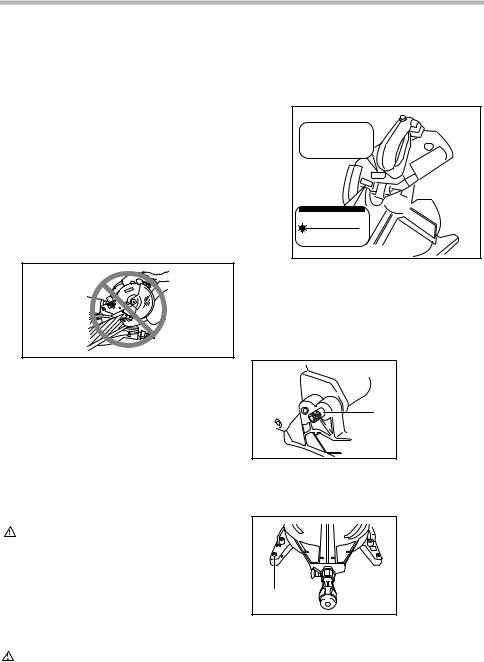
24. |
Wait until the blade attains full speed before cut- |
• |
|
ting. |
|
25. |
Stop operation immediately if you notice any- |
• |
|
thing abnormal. |
|
26.Do not attempt to lock the trigger in the on position.
27.Be alert at all times, especially during repetitive, monotonous operations. Do not be lulled into a false sense of security. Blades are extremely unforgiving.
28.Always use accessories recommended in this manual. Use of improper accessories such as abrasive wheels may cause an injury.
29.NEVER hold workpiece on right side of blade with left hand or vice versa. This is called crossarmed cutting and exposes user to risk of SERIOUS PERSONAL INJURY as shown in the figure. ALWAYS use vise to secure workpiece.
AVOID EXPOSURE – LASER RADIATION IS EMITTED FROM APERTURE.
USE OF CONTROLS OR ADJUSTMENTS OR PERFORMANCE OF PROCEDURES OTHER THAN THOSE SPECIFIED HEREIN MAY RESULT IN HAZARDOUS RADIATION EXPOSURE.
Complies with 21CFR 1040.10 and 1040.11 AVOID EXPOSURE-Laser radiation is emitted from this aperture
CAUTION
LASER RADIATION
DO NOT STARE INTO BEAM
Maximum Output <1mW,Wavelength:655nm CLASS II LASER PRODUCT
30.Do not abuse cord. Never yank cord to disconnect it from the receptacle. Keep cord away from heat, oil, water and sharp objects.
31.NEVER stack workpieces on the table top to speed cutting operations. Cut only one piece at a time.
32.Some material contains chemicals which may be toxic. Take caution to prevent dust inhalation and skin contact. Follow material supplier safety data.
SAVE THESE INSTRUCTIONS
WARNING:
MISUSE or failure to follow the safety rules stated in this instruction manual may cause serious personal injury.
ADDITIONAL SAFETY RULES FOR THE LASER
USB088-1
CAUTION:
• LASER RADIATION DO NOT STARE INTO BEAM.
INSTALLATION
Bench mounting
When the tool is shipped, the handle is locked in the lowered position by the stopper pin. Release the stopper pin by lowering the handle slightly and pulling the stopper pin.
001564
1. Stopper pin
1
This tool should be bolted with four bolts to a level and stable surface using the bolt holes provided in the tool’s base. This will help prevent tipping and possible injury.
001531
1. Bolt
1
5
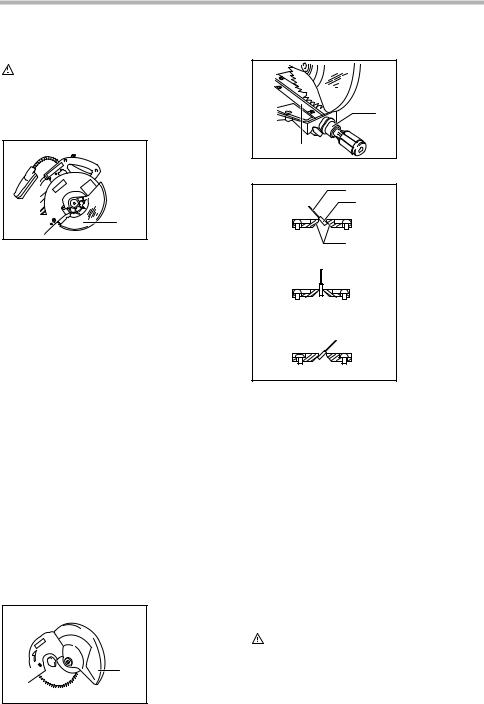
FUNCTIONAL DESCRIPTION
CAUTION:
•Always be sure that the tool is switched off and unplugged before adjusting or checking function on the tool.
Blade guard
002016
1. Blade guard
1
When lowering the handle, the blade guard rises automatically. The blade guard returns to its original position when the cut is completed and the handle is raised. NEVER DEFEAT OR REMOVE THE BLADE GUARD OR THE SPRING WHICH ATTACHES TO THE GUARD.
In the interest of your personal safety, always maintain the blade guard in good condition. Any irregular operation of the blade guard should be corrected immediately. Check to assure spring loaded return action of guard. NEVER USE THE TOOL IF THE BLADE GUARD OR SPRING ARE DAMAGED, FAULTY OR REMOVED. DOING SO IS HIGHLY DANGEROUS AND CAN CAUSE SERIOUS PERSONAL INJURY.
If the see-through blade guard becomes dirty, or sawdust adheres to it in such a way that the blade and/or workpiece is no longer easily visible, unplug the saw and clean the guard carefully with a damp cloth. Do not use solvents or any petroleum-based cleaners on the plastic guard.
If the blade guard is especially dirty and vision through the guard is impaired, use the supplied socket wrench to loosen the hex bolt holding the center cover. Loosen the hex bolt by turning it counterclockwise and raise the blade guard and center cover. With the blade guard so positioned, cleaning can be more completely and efficiently accomplished. When cleaning is complete, reverse procedure above and secure bolt. Do not remove spring holding blade guard. If guard becomes discolored through age or UV light exposure, contact a Makita service center for a new guard. DO NOT DEFEAT OR REMOVE GUARD.
001782
1. Blade guard
1
Positioning kerf board
|
001537 |
|
|
|
1. |
Knob |
|
|
2. |
Kerf board |
|
|
1 |
|
|
2 |
|
|
|
|
001538 |
|
|
1 |
1. |
Saw blade |
|
2 |
2. |
Blade teeth |
|
|
3. |
Kerf board |
|
|
4. |
Left bevel cut |
|
3 |
5. |
Straight cut |
|
6. |
Right bevel cut |
||
4 |
|||
|
|
5
6
This tool is provided with the kerf boards in the turn base to minimize tearing on the exit side of a cut. The kerf boards are factory adjusted so that the saw blade does not contact the kerf boards. Before use, adjust the kerf boards as follows:
First, unplug the tool. Loosen all the screws (2 each on left and right) securing the kerf boards. Re-tighten them only to the extent that the kerf boards can still be easily moved by hand. Lower the handle fully and push in the stopper pin to lock the handle in the lowered position. Loosen the knob which secures the slide poles. Pull the carriage toward you fully. Adjust the kerf boards so that the kerf boards just contact the sides of the blade teeth. Tighten the front screws (do not tighten firmly). Push the carriage toward the guide fence fully and adjust the kerf boards so that the kerf boards just contact the sides of blade teeth. Tighten the rear screws (do not tighten firmly).
After adjusting the kerf boards, release the stopper pin and raise the handle. Then tighten all the screws securely.
CAUTION:
•Before and after changing the bevel angle, always adjust the kerf boards as described above.
6
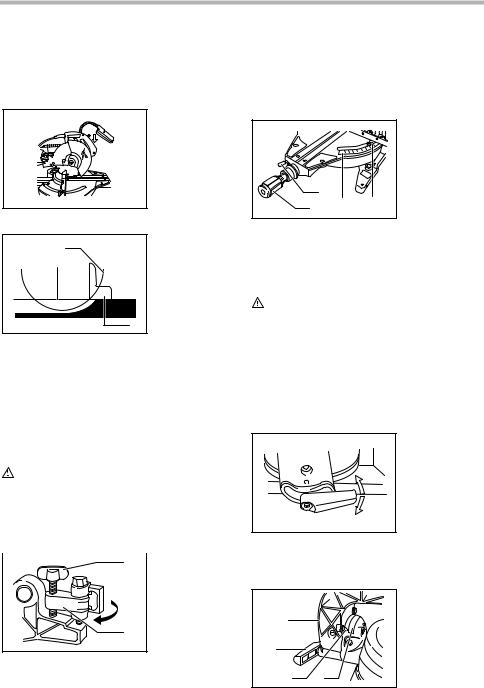
Maintaining maximum cutting capacity
This tool is factory adjusted to provide the maximum cutting capacity for a 305 mm (12”) saw blade.
When installing a new blade, always check the lower limit position of the blade and if necessary, adjust it as follows:
004066
1. Adjusting bolt 2. Turn base
1
 2
2
001540 |
2 |
1 |
3 |
1.Top surface of turn base
2.Periphery of blade
3.Guide fence
First, unplug the tool. Push the carriage toward the guide fence fully and lower the handle completely. Use the socket wrench to turn the adjusting bolt until the periphery of the blade extends slightly below the top surface of the turn base at the point where the front face of the guide fence meets the top surface of the turn base.
With the tool unplugged, rotate the blade by hand while holding the handle all the way down to be sure that the blade does not contact any part of the lower base. Readjust slightly, if necessary.
CAUTION:
•After installing a new blade, always be sure that the blade does not contact any part of the lower base when the handle is lowered completely. Always do this with the tool unplugged.
Stopper arm
001562 |
|
|
1 |
1. |
Adjusting screw |
|
2. |
Stopper arm |
2
The lower limit position of the blade can be easily adjusted with the stopper arm. To adjust it, rotate the stopper arm in the direction of the arrow as shown in the figure. Adjust the adjusting screw so that the blade stops at the desired position when lowering the handle fully.
Adjusting the miter angle
|
|
001541 |
|
1 |
|
2 |
4 |
3 |
|
|
1.Lock lever
2.Grip
3.Pointer
4.Miter scale
Loosen the grip by turning counterclockwise. Turn the turn base while pressing down the lock lever. When you have moved the grip to the position where the pointer points to the desired angle on the miter scale, securely tighten the grip clockwise.
CAUTION:
•When turning the turn base, be sure to raise the handle fully.
•After changing the miter angle, always secure the turn base by tightening the grip firmly.
Adjusting the bevel angle
To adjust the bevel angle, loosen the lever at the rear of the tool counterclockwise. Unlock the arm by pushing the handle somewhat strongly in the direction that you intend to tilt the saw blade.
004056
1. Lever
1 
Tilt the saw blade until the pointer points to the desired angle on the bevel scale. Then tighten the lever clockwise firmly to secure the arm.
001543
1. Arm 2. Lever
1 |
3. Pointer |
4. Bevel scale
2
3 4
7
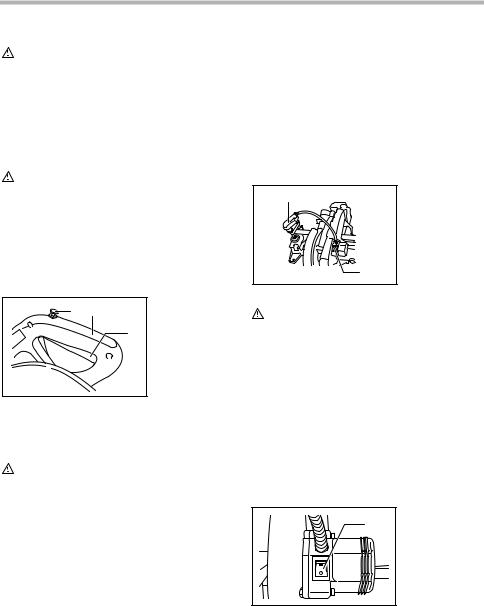
CAUTION:
•When tilting the saw blade, be sure to raise the handle fully.
•After changing the bevel angle, always secure the arm by tightening the lever clockwise.
•When changing bevel angles, be sure to position the kerf boards appropriately as explained in the “Positioning kerf boards” section.
Switch action
CAUTION:
•Before plugging in the tool, always check to see that the switch trigger actuates properly and returns to the “OFF” position when released.
•When not using the tool, remove the lock-off button and store it in a secure place. This prevents unauthorized operation.
•Do not pull the switch trigger hard without pressing in the lock-off button. This can cause switch breakage.
|
|
001551 |
|
|
1 |
2 |
|
1. |
Lock-off button |
|
2. |
Handle |
||
|
|
|
||
|
|
3 |
3. |
Switch trigger |
|
|
|
|
To prevent the switch trigger from being accidentally pulled, a lock-off button is provided. To start the tool, press in the lock-off button and pull the switch trigger. Release the switch trigger to stop.
WARNING:
•NEVER use tool without a fully operative switch trigger. Any tool with an inoperative switch is HIGHLY DANGEROUS and must be repaired before further usage.
•For your safety, this tool is equipped with a lock-off button which prevents the tool from unintended starting. NEVER use the tool if it runs when you simply pull the switch trigger without pressing the lock-off button. Return tool to a Makita service center for proper repairs BEFORE further usage.
•NEVER tape down or defeat purpose and function of lock-off button.
Electric brake
This tool is equipped with an electric blade brake. If the tool consistently fails to quickly stop blade after switch trigger release, have tool serviced at a Makita service center.
The blade brake system is not a substitute for blade guard. NEVER USE TOOL WITHOUT A FUNCTIONING BLADE GUARD. SERIOUS PERSONAL INJURY CAN RESULT.
Lighting up the lamps
For Model LS1214F only
|
002026 |
|
|
1 |
1. |
Light |
|
2. |
Light switch |
||
|
2
CAUTION:
•This is not a rainproof light. Do not wash the light in water or use it in a rain or a wet area. Such a conduct can cause an electric shock and fume.
•Do not touch the lens of the light, as it is very hot while it is lighted or shortly after it is turned off. This may cause a burn to a human body.
•Do not apply impact to the light, which may cause damage or shorted service time to it.
•Do not keep casting the beam of the light to your eyes. This can cause your eyes to be hurt.
•Do not cover the light with clothes, carton, cardboard or similar objects while it is lighted, which can cause a fire or an ignition.
Push the upper position of the switch for turning on the light and the lower position for off.
003826
1. Light switch
1
Move the light to shift an area of lighting.
NOTE:
•Use a dry cloth to wipe the dirt off the lens of lamp. Be careful not to scratch the lens of light, or it may lower the illumination.
8
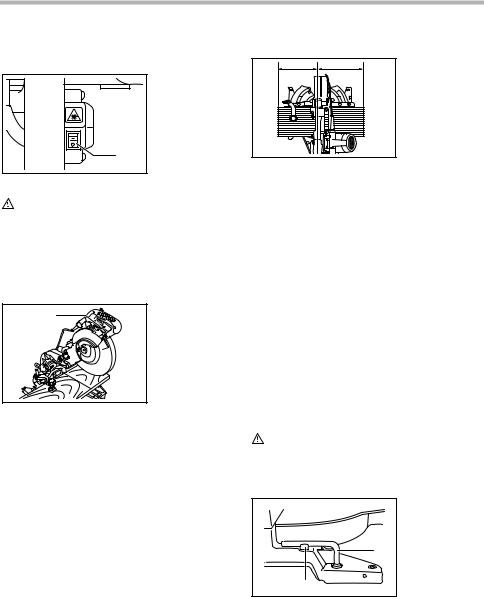
Laser beam action
For model LS1214L only
006339
1. Switch for laser
1
CAUTION:
•LASER RADIATION Do not stare into beam.
To turn on the laser beam, press the upper position (I) of the switch. Press the lower position (O) to turn off.
Laser line can be shifted to either the left or right side of the saw blade by adjusting the adjusting screw as follows.
006340
1 |
1. Adjusting screw |
|
1.Loosen the adjusting screw by turning it counterclockwise.
2.With the adjusting screw loosened, slide the adjusting screw to the right or left as far as it goes.
3.Tighten the adjusting screw firmly at the position where it stops sliding.
Laser line is factory adjusted so that it is positioned within 1 mm (0.04”) from the side surface of the blade (cutting position).
NOTE:
•When laser line is dim and almost or entirely invisible because of the direct sunlight in the indoor or outdoor window-by work, relocate the work area to a place not exposed to the direct sunlight.
Aligning the laser line
006341
A B
Laser line can be shifted to either the left or right side of the blade according to the applications of cutting. Refer to explanation titled “Laser beam action” regarding its shifting method.
NOTE:
•Use wood facing against the guide fence when aligning the cutting line with the laser line at the side of guide fence in compound cutting (bevel angle 45 degrees and miter angle right 45 degrees).
A) When you obtain correct size on the left side of workpiece
•Shift the laser line to the left of the blade.
B) When you obtain correct size on the right side of workpiece
•Shift the laser line to the right of the blade.
Align the cutting line on your workpiece with the laser line.
ASSEMBLY
CAUTION:
•Always be sure that the tool is switched off and unplugged before carrying out any work on the tool.
Socket wrench storage
001530
1. Socket wrench
2. Wrench holder
1
2
The socket wrench is stored as shown in the figure. When using the socket wrench, pull it out of the wrench holder. After using the socket wrench, return it to the wrench holder.
9
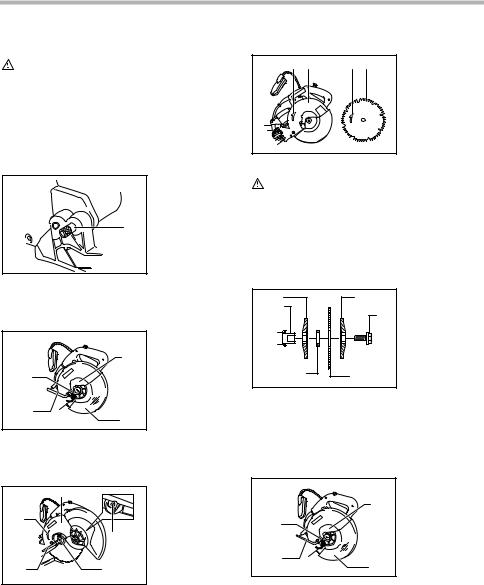
Installing or removing saw blade
CAUTION:
•Always be sure that the tool is switched off and unplugged before installing or removing the blade.
•Use only the Makita socket wrench provided to install or remove the blade. Failure to do so may result in overtightening or insufficient tightening of the hex bolt. This could cause an injury.
Lock the handle in the raised position by pushing in the stopper pin.
001564
1. Stopper pin
1
To remove the blade, use the socket wrench to loosen the hex bolt holding the center cover by turning it counterclockwise. Raise the blade guard and center cover.
002019
1. Center cover 2. Hex bolt
1 3. Socket wrench 4. Blade guard
2
3
4
Press the shaft lock to lock the spindle and use the socket wrench to loosen the hex bolt clockwise. Then remove the hex bolt, outer flange and blade.
|
002020 |
|
1 |
2 |
|
|
3 |
5 |
4 |
1.Blade case
2.Arrow
3.Shaft lock
4.Hex bolt
5.Socket wrench
To install the blade, mount it carefully onto the spindle, making sure that the direction of the arrow on the surface of the blade matches the direction of the arrow on the blade case.
Install the outer flange and hex bolt, and then use the socket wrench to tighten the hex bolt (left-handed) securely counterclockwise while pressing the shaft lock.
|
|
002021 |
|
2 1 |
4 3 |
1. |
Blade case |
|
|
2. |
Arrow |
|
|
3. |
Saw blade |
|
|
4. |
Arrow |
CAUTION:
•The black ring 25 mm in outer diameter and the silver ring 25.4 mm in outer diameter are factoryinstalled as shown in the figure. When using a blade with 25 mm hole diameter, replace the silver ring with the black ring. Before mounting the blade onto the spindle, always be sure that the correct ring for the arbor hole of the blade you intend to use is installed between the inner and outer flanges.
|
|
|
004058 |
|
|
1 |
|
5 |
|
1. |
Inner flange |
2 |
|
|
6 |
2. |
Spindle |
|
|
|
3. |
Ring |
|
|
|
|
|
||
|
|
|
|
4. |
Saw blade |
|
|
|
|
5. |
Outer flange |
|
|
|
|
6. |
Hex bolt |
|
3 |
4 |
|
|
(left-handed) |
|
|
|
|
||
|
|
|
|
|
Return the blade guard and center cover to its original position. Then tighten the hex bolt clockwise to secure the center cover. Release the handle from the raised position by pulling the stopper pin. Lower the handle to make sure that the blade guard moves properly. Make sure shaft lock has released spindle before making cut.
002019
1. Center cover 2. Hex bolt
1 3. Socket wrench 4. Blade guard
2
3
4
10
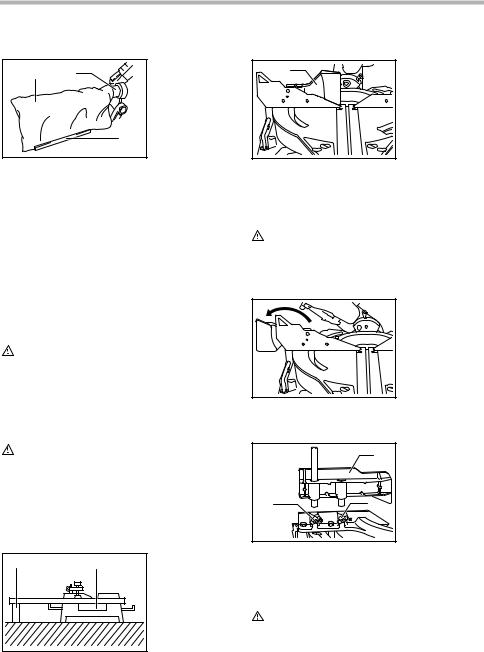
Dust bag |
Sub-fence |
|
|
001536 |
|
|
005593 |
2 |
1 |
1. |
Dust nozzle |
1 |
1. Sub-fence |
2. |
Dust bag |
|
|||
|
|
|
|
||
|
|
3. |
Fastener |
|
|
|
|
3 |
|
|
|
The use of the dust bag makes cutting operations clean and dust collection easy. To attach the dust bag, insert the dust nozzle into the dust spout on the blade case and fit the bag’s entry port over the dust nozzle.
When the dust bag is about half full, remove the dust bag from the tool and pull the fastener out. Empty the dust bag of its contents, tapping it lightly so as to remove particles adhering to the insides which might hamper further collection.
NOTE:
If you connect a vacuum cleaner to your saw, more efficient and cleaner operations can be performed.
Securing workpiece
WARNING:
•It is extremely important to always secure the workpiece properly and tightly with the vise. Failure to do so can cause the tool to be damaged and/or the workpiece to be destroyed. PERSONAL INJURY MAY ALSO RESULT. Also, after a cutting operation, DO NOT raise the blade until the blade has come to a complete stop.
CAUTION:
•When cutting long workpieces, use supports that are as high as the top surface level of the turn base. Do not rely solely on the vertical vise and/or horizontal vise to secure the workpiece.
Thin material tends to sag. Support workpiece over its entire length to avoid blade pinch and possible KICKBACK.
|
001549 |
1 |
2 |
1.Support
2.Turn base
This tool is equipped with the sub-fence which should ordinarily be positioned as shown in the figure.
However, when performing left bevel cuts, set it to the left position as shown in the figure.
CAUTION:
•When performing left bevel cuts, flip the fence over to the left position as shown in the figure. Otherwise, it will contact the blade or a part of the tool, causing possible serious injury to the operator.
005594
1. Sub-fence
 1
1
Sub-fence R
|
005595 |
|
|
1 |
1. Sub-fence R |
|
2. Screws |
|
|
|
|
2 |
2 |
|
The sub-fence R can be installed on the right side of the guide fence. Insert the rods of the sub-fence R into the holes in the guide fence. Tighten the screws which come with the sub-fence R to secure the sub-fence R.
CAUTION:
•When performing right bevel cuts, never use the sub-fence R. It will contact the blade or a part of the tool, causing possible serious injury to the operator.
11

Vertical vise
005597
1 |
3 |
2 |
4 |
|
|
5 |
|
|
005688 |
|
3 |
|
1 |
2 |
5 |
|
||
|
4 |
|
|
|
1.Vise rod
2.Screw
3.Vise knob
4.Vise arm
5.Guide fence
1.Sub-fence R
2.Screw
3.Rod
4.Vise rod
5.Vise arm
The vertical vise can be installed in two positions on either the left or right side of the guide fence. Insert the vise rod into the hole in the guide fence and tighten the screw on the back of the guide fence to secure the vise rod.
The vertical vise can also be secured to the rod on the right side of the sub-fence R.
Position the vise arm according to the thickness and shape of the workpiece and secure the vise arm by tightening the screw. If the screw to secure the vise arm contacts the guide fence, install the screw on the opposite side of vise arm. Make sure that no part of the tool contacts the vise when lowering the handle fully and pulling or pushing the carriage all the way. If some part contacts the vise, re-position the vise.
Press the workpiece flat against the guide fence and the turn base. Position the workpiece at the desired cutting position and secure it firmly by tightening the vise knob.
CAUTION:
•The workpiece must be secured firmly against the turn base and guide fence with the vise during all operations.
Horizontal vise (optional accessory)
|
001550 |
|
1 |
2 |
3 |
1.Vise plate
2.Vise nut
3.Vise knob
The horizontal vise can be installed in two positions on either the left or right side of the base. When performing 15° or greater miter cuts, install the horizontal vise on the side opposite the direction in which the turn base is to be turned.
005232 |
By flipping the vise nut to the left, the vise is released, and rapidly moves in and out. To grip the workpiece, push the vise knob forward until the vise plate contacts the workpiece and flip the vise nut to the right. Then turn the vise knob clockwise to secure the workpiece.
The maximum width of workpiece which can be secured by the horizontal vise is 200 mm (7-7/8”).
When installing the horizontal vise on the right side of the base, also use the sub-fence R to secure the workpiece more firmly. Refer to the “Sub-fence R” section described on previously for installing the sub-fence R.
CAUTION:
•Always rotate the vise nut to the right fully when securing the workpiece. Failure to do so may result in insufficient securing of the workpiece. This could cause the workpiece to be thrown, cause damage to the blade or cause the loss of control, which can result in PERSONAL INJURY.
Holders
001544
1. Holder
1
The holders can be installed on either side as a convenient means of holding workpieces horizontally. Slip the holder rods into the holes in the base and adjust their length according to the workpiece to be held. Then tighten the holders securely with the screws.
CAUTION:
•Always support long workpieces level with the top surface of the turn base for accurate cuts and to prevent dangerous loss of control of the tool.
12
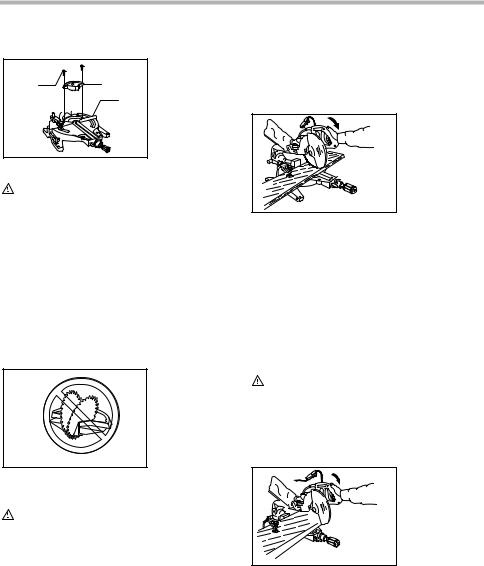
Kerf block (optional accessory)
|
|
004861 |
|
|
|
|
1. |
Screw |
|
1 |
2 |
2. |
Kerf block |
|
3. |
Guide fence |
|||
|
|
3
CAUTION:
•When using the kerf block, always cut at the same miter angle.
•When changing the miter angle, use other kerf blocks.
•When performing bevel cuts, never use the kerf block.
Failure to do so splits the block, causing a serious injury to operator.
When you use the kerf block at 90° cutting, you can splin- ter-free cut in workpiece on the side of the guide fence (height of the workpiece is up to 35 mm). Install the kerf block onto the guide fence by means of the two screws. (Adjust the guide fence and the kerf block so that they contact their faces. Then tighten the screws securely.)
005598
OPERATION
CAUTION:
•Before use, be sure to release the handle from the lowered position by pulling the stopper pin.
•Make sure the blade is not contacting the workpiece, etc. before the switch is turned on.
•Do not apply excessive pressure on the handle when cutting. Too much force may result in overload of the motor and/or decreased cutting efficiency. Push down handle with only as much force as is necessary for smooth cutting and without significant decrease in blade speed.
•Gently press down the handle to perform the cut. If the handle is pressed down with force or if lateral force is applied, the blade will vibrate and leave a mark (saw mark) in the workpiece and the precision of the cut will be impaired.
•During a slide cut, gently push the carriage toward the guide fence without stopping. If the carriage movement is stopped during the cut, a mark will be left in the workpiece and the precision of the cut will be impaired.
1.Press cutting (cutting small workpieces)
002022
1. Knob



 1
1
Workpieces up to 115 mm (4-1/2”) high and 75 mm (2-15/16”) wide can be cut in the following way. Push the carriage toward the guide fence fully and tighten the knob clockwise to secure the carriage. Secure the workpiece with the vise. Switch on the tool without the blade making any contact and wait until the blade attains full speed before lowering. Then gently lower the handle to the fully lowered position to cut the workpiece. When the cut is completed, switch off the tool and WAIT UNTIL THE BLADE HAS COME TO A COMPLETE STOP before returning the blade to its fully elevated position.
CAUTION:
•Firmly tighten the knob clockwise so that the carriage will not move during operation. Insufficient tightening may cause unexpected kickback of the blade. Possible serious PERSONAL INJURY may result.
2.Slide (push) cutting (cutting wide workpieces)
002023
1. Knob
 1
1
Loosen the knob counterclockwise so that the carriage can slide freely. Secure the workpiece with the vise. Pull the carriage toward you fully. Switch on the tool without the blade making any contact and wait until the blade attains full speed. Press down the handle and PUSH THE CARRIAGE TOWARD THE GUIDE FENCE AND THROUGH THE WORKPIECE. When the cut is completed, switch off the tool and WAIT UNTIL THE BLADE HAS COME TO A COMPLETE STOP before returning the blade to its fully elevated position.
13
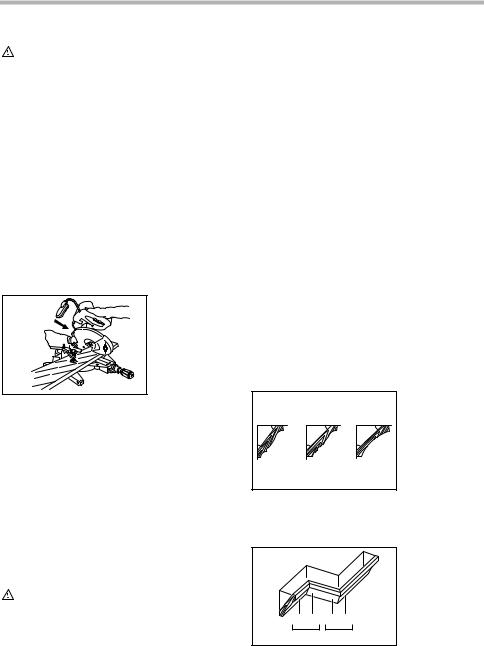
CAUTION:
•Whenever performing the slide cut, FIRST PULL THE CARRIAGE TOWARD YOU FULLY and press down the handle to the fully lowered position, then PUSH THE CARRIAGE TOWARD THE GUIDE FENCE. NEVER START THE CUT WITH THE CARRIAGE NOT FULLY PULLED TOWARD YOU. If you perform the slide cut without pulling the carriage fully or if you perform the slide cut toward your direction, the blade may kickback unexpectedly with the potential to cause serious PERSONAL INJURY.
•Never perform the slide cut with the handle locked in the lowered position by pressing the stopper pin.
•Never loosen the knob which secures the carriage while the blade is rotating. This may cause serious injury.
3.Miter cutting
Refer to the previously covered “Adjusting the miter angle”.
4.Bevel cut
002024
Loosen the lever and tilt the saw blade to set the bevel angle (Refer to the previously covered “Adjusting the bevel angle”). Be sure to retighten the lever firmly to secure the selected bevel angle safely. Secure the workpiece with a vise. Make sure the carriage is pulled all the way back toward the operator. Switch on the tool without the blade making any contact and wait until the blade attains full speed. Then gently lower the handle to the fully lowered position while applying pressure in parallel with the blade and PUSH THE CARRIAGE TOWARD THE GUIDE FENCE TO CUT THE WORKPIECE. When the cut is completed, switch off the tool and WAIT UNTIL THE BLADE HAS COME TO A COMPLETE STOP before returning the blade to its fully elevated position.
CAUTION:
•Always be sure that the blade will move down to bevel direction during a bevel cut. Keep hands out of path of saw blade.
•During a bevel cut, it may create a condition whereby the piece cut off will come to rest against the side of the blade. If the blade is raised while the blade is still rotating, this piece may be caught by the blade, causing fragments to be scattered which
is dangerous. The blade should be raised ONLY after the blade has come to a complete stop.
•When pressing down the handle, apply pressure in parallel with the blade. If a force is applied perpendicularly to the turn base or if the pressure direction is changed during a cut, the precision of the cut will be impaired.
•Always set the sub-fence to the left position when performing left bevel cuts.
5.Compound cutting
Compound cutting is the process in which a bevel angle is made at the same time in which a miter angle is being cut on a workpiece. Compound cutting can be performed at angle shown in the table.
|
006484 |
Miter angle |
Bevel angle |
Left and Right 45˚ |
Left and Right 0˚ - 45˚ |
Left 47˚ |
Left 0˚ - 45˚ and Right 0˚ - 40˚ |
Right 52˚ |
Left 0˚ - 30˚ and Right 0˚ - 45˚ |
When performing compound cutting, refer to “Press cutting”, “Slide cutting”, “Miter cutting” and “Bevel cut” explanations.
6.Cutting crown and cove moldings
Crown and cove moldings can be cut on a compound miter saw with the moldings laid flat on the turn base.
There are two common types of crown moldings and one type of cove moldings; 52/38° wall angle crown molding, 45° wall angle crown molding and 45° wall angle cove molding. See illustrations.
|
|
001555 |
|
|
|
|
|
1. |
52/38° type |
|
|
|
|
crown molding |
52∞ |
45∞ |
45∞ |
2. |
45° type crown |
|
molding |
|||
|
|
|
|
|
38∞ |
45∞ |
45∞ |
3. |
45° type cove |
|
|
|
||
|
|
|
|
molding |
1 |
2 |
3 |
|
|
There are crown and cove molding joints which are made to fit “Inside” 90° corners ((1) and (2) in Fig. A) and “Outside” 90° corners ((3) and (4) in Fig. A).
001556
1. Inside corner
2. Outside corner
(1) (2) |
(3) (4) |
Fig.A 1 2
14

|
|
001557 |
1 |
(2) |
(1) |
|
||
|
(1) |
(2) |
(2) |
(4) |
2 |
(3) |
||
(1) |
|
|
(2) |
|
(1) |
(1) |
|
(2) |
1.Inside corner
2.Outside corner
Measuring
Measure the wall length and adjust workpiece on table to cut wall contact edge to desired length. Always make sure that cut workpiece length at the back of the workpiece is the same as wall length. Adjust cut length for angle of cut. Always use several pieces for test cuts to check the saw angles.
When cutting crown and cove moldings, set the bevel angle and miter angle as indicated in the table (A) and position the moldings on the top surface of the saw base as indicated in the table (B).
In the case of left bevel cut
|
|
|
|
|
|
|
006361 |
|
|
|
Table (A) |
|
|
|
|
||
|
|
|
|
|
|
|
||
|
Molding |
Bevel angle |
|
Miter angle |
||||
|
position in |
52/38˚ type |
45˚ type |
|
|
|
45˚ type |
|
|
Fig. A |
52/38˚ type |
|
|||||
|
|
|
|
|
|
|
|
|
For inside |
(1) |
|
|
Right 31.6˚ |
|
Right 35.3˚ |
||
corner |
(2) |
Left 33.9˚ |
Left 30˚ |
Left 31.6˚ |
|
Left 35.3˚ |
||
For outside |
(3) |
|
||||||
|
|
|
|
|||||
|
|
|
|
|
|
|||
corner |
(4) |
|
|
Right 31.6˚ |
|
Right 35.3˚ |
||
|
|
|
|
|
|
|
006362 |
|
|
|
Table (B) |
|
|
|
|
||
|
|
|
|
|
|
|
|
|
|
Molding |
Molding edge against |
|
|
|
|||
|
position in |
Finished piece |
||||||
|
guide fence |
|
||||||
|
Fig. A |
|
|
|
|
|||
|
|
|
|
|
|
|
||
|
|
|
|
|
|
|||
|
(1) |
Ceiling contact edge should |
Finished piece |
|||||
For inside |
be against guide fence. |
|
||||||
|
|
will be on the |
||||||
|
|
|
|
|||||
corner |
(2) |
|
|
|
Left side of |
|||
|
Wall contact edge should be |
blade. |
|
|||||
|
|
|
|
|
||||
For |
(3) |
against guide fence. |
|
Finished piece |
||||
|
|
|
||||||
outside |
|
|
|
|
will be on the |
|||
|
Ceiling contact edge should |
Right side of |
||||||
corner |
(4) |
|||||||
blade. |
|
|||||||
|
be against guide fence. |
|
|
|||||
|
|
|
|
|
|
|||
|
|
|
|
|
|
|
|
|
Example:
In the case of cutting 52/38° type crown molding for position (1) in Fig. A:
•Tilt and secure bevel angle setting to 33.9° LEFT.
•Adjust and secure miter angle setting to 31.6° RIGHT.
•Lay crown molding with its broad back (hidden) surface down on the turn base with its CEILING CONTACT EDGE against the guide fence on the saw.
•The finished piece to be used will always be on the LEFT side of the blade after the cut has been made.
In the case of right bevel cut
|
|
|
|
|
|
|
006363 |
|
|
Table (A) |
|
|
|
||
|
|
|
|
|
|
|
|
|
Molding |
Bevel angle |
|
|
Miter angle |
||
|
position in |
52/38˚ type |
45˚ type |
|
|
|
45˚ type |
|
Fig. A |
52/38˚ type |
|||||
|
|
|
|
|
|
|
|
For inside |
(1) |
|
|
|
Right 31.6˚ |
Right 35.3˚ |
|
corner |
(2) |
Right 33.9˚ |
Right 30˚ |
|
Left 31.6˚ |
Left 35.3˚ |
|
For outside |
(3) |
|
|||||
|
|
|
|
||||
|
|
|
|
|
|
||
corner |
(4) |
|
|
|
Right 31.6˚ |
Right 35.3˚ |
|
|
|
|
|
|
|
|
006364 |
|
|
Table (B) |
|
|
|
||
|
|
|
|
|
|
|
|
|
Molding |
Molding edge against |
|
|
|||
|
position in |
Finished piece |
|||||
|
guide fence |
|
|||||
|
Fig. A |
|
|
|
|||
|
|
|
|
|
|
|
|
|
|
|
|
||||
|
(1) |
Wall contact edge should be |
Finished piece |
||||
For inside |
against guide fence. |
|
will be on the |
||||
|
|
||||||
corner |
|
|
|
|
|
Right side of |
|
|
(2) |
Ceiling contact edge should |
blade. |
||||
|
|
|
|
||||
|
|
be against guide fence. |
|
|
|
||
For |
(3) |
|
Finished piece |
||||
|
|
|
|
||||
|
|
|
|
will be on the |
|||
outside |
|
|
|
|
|
||
|
|
|
|
|
Left side of |
||
|
Wall contact edge should be |
||||||
corner |
(4) |
blade. |
|||||
|
against guide fence. |
|
|||||
|
|
|
|
|
|||
|
|
|
|
|
|
|
|
Example:
In the case of cutting 52/38° type crown molding for position (1) in Fig. A:
•Tilt and secure bevel angle setting to 33.9° RIGHT.
•Adjust and secure miter angle setting to 31.6° RIGHT.
•Lay crown molding with its broad back (hidden) surface down on the turn base with its WALL CONTACT EDGE against the guide fence on the saw.
•The finished piece to be used will always be on the RIGHT side of the blade after the cut has been made.
15
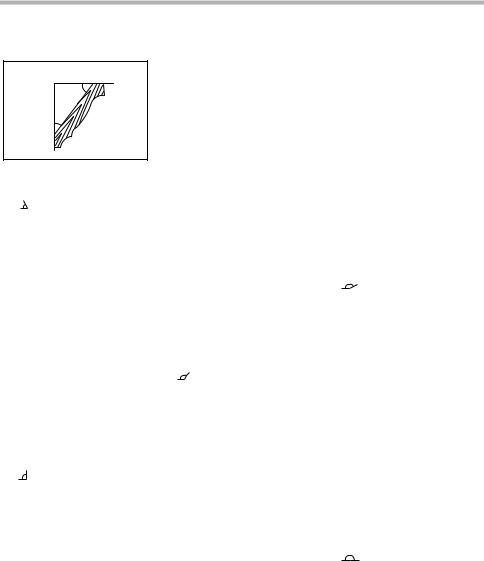
Wall
EN0002-1 |
Compound Miter Saw |
000031 |
Miter and Bevel Angle Settings |
Ceiling
52˚
38˚
Wall to Crown Molding Angle: 52/38 degrees
Wall Angle |
Bevel Angle |
Miter Angle |
|
Wall Angle |
Bevel Angle |
Miter Angle |
|
Wall Angle |
Bevel Angle |
Miter Angle |
(deg.) |
(deg.) |
(deg.) |
|
(deg.) |
(deg.) |
(deg.) |
|
(deg.) |
(deg.) |
(deg.) |
60 |
43.0 |
46.8 |
|
101 |
30.1 |
26.9 |
|
141 |
15.3 |
12.3 |
61 |
42.8 |
46.3 |
|
102 |
29.7 |
26.5 |
|
142 |
14.9 |
12.0 |
62 |
42.5 |
45.7 |
|
103 |
29.4 |
26.1 |
|
143 |
14.5 |
11.6 |
63 |
42.2 |
45.1 |
|
104 |
29.0 |
25.7 |
|
144 |
14.1 |
11.3 |
64 |
41.9 |
44.6 |
|
105 |
28.7 |
25.3 |
|
145 |
13.7 |
11.0 |
65 |
41.7 |
44.0 |
|
106 |
28.3 |
24.9 |
|
146 |
13.3 |
10.7 |
66 |
41.4 |
43.5 |
|
107 |
28.0 |
24.5 |
|
147 |
12.9 |
10.3 |
67 |
41.1 |
42.9 |
|
108 |
27.6 |
24.1 |
|
148 |
12.5 |
10.0 |
68 |
40.8 |
42.4 |
|
109 |
27.2 |
23.7 |
|
149 |
12.2 |
9.7 |
69 |
40.5 |
41.9 |
|
110 |
26.9 |
23.3 |
|
150 |
11.8 |
9.4 |
70 |
40.2 |
41.3 |
|
111 |
26.5 |
22.9 |
|
151 |
11.4 |
9.0 |
71 |
39.9 |
40.8 |
|
112 |
26.1 |
22.6 |
|
152 |
11.0 |
8.7 |
72 |
39.6 |
40.3 |
|
113 |
25.8 |
22.2 |
|
153 |
10.8 |
8.4 |
73 |
39.3 |
39.8 |
|
114 |
25.4 |
21.8 |
|
154 |
10.2 |
8.1 |
74 |
39.0 |
39.2 |
|
115 |
25.0 |
21.4 |
|
155 |
9.8 |
7.8 |
75 |
38.7 |
38.7 |
|
116 |
24.7 |
21.0 |
|
156 |
9.4 |
7.5 |
76 |
38.4 |
38.2 |
|
117 |
24.3 |
20.7 |
|
157 |
9.0 |
7.1 |
77 |
38.1 |
37.7 |
|
118 |
23.9 |
20.3 |
|
158 |
8.6 |
6.8 |
78 |
37.8 |
37.2 |
|
119 |
23.6 |
19.9 |
|
159 |
8.3 |
6.5 |
79 |
37.4 |
36.8 |
|
120 |
23.2 |
19.6 |
|
160 |
7.9 |
6.2 |
|
|
|
|
|
|
|
|
|
|
|
80 |
37.1 |
36.3 |
|
121 |
22.8 |
19.2 |
|
161 |
7.5 |
5.9 |
81 |
36.8 |
35.8 |
|
122 |
22.5 |
18.8 |
|
162 |
7.1 |
5.6 |
82 |
36.5 |
35.3 |
|
123 |
22.1 |
18.5 |
|
163 |
6.7 |
5.3 |
83 |
36.2 |
34.8 |
|
124 |
21.7 |
18.1 |
|
164 |
6.3 |
4.9 |
84 |
35.8 |
34.4 |
|
125 |
21.3 |
17.8 |
|
165 |
5.9 |
4.6 |
85 |
35.5 |
33.9 |
|
126 |
21.0 |
17.4 |
|
166 |
5.5 |
4.3 |
86 |
35.2 |
33.4 |
|
127 |
20.6 |
17.1 |
|
167 |
5.1 |
4.0 |
87 |
34.9 |
33.0 |
|
128 |
20.2 |
16.7 |
|
168 |
4.7 |
3.7 |
88 |
34.5 |
32.5 |
|
129 |
19.8 |
16.4 |
|
169 |
4.3 |
3.4 |
89 |
34.2 |
32.1 |
|
130 |
19.5 |
16.0 |
|
170 |
3.9 |
3.1 |
90 |
33.9 |
31.6 |
|
131 |
19.1 |
15.7 |
|
171 |
3.5 |
2.8 |
|
|
|
|
|
|
|
|
|
|
|
91 |
33.5 |
31.2 |
|
132 |
18.7 |
15.3 |
|
172 |
3.2 |
2.5 |
92 |
33.2 |
30.7 |
|
133 |
18.3 |
15.0 |
|
173 |
2.8 |
2.2 |
93 |
32.8 |
30.3 |
|
134 |
17.9 |
14.6 |
|
174 |
2.4 |
1.8 |
94 |
32.5 |
29.9 |
|
135 |
17.6 |
14.3 |
|
175 |
2.0 |
1.5 |
95 |
32.2 |
29.4 |
|
136 |
17.2 |
14.0 |
|
176 |
1.6 |
1.2 |
96 |
31.8 |
29.0 |
|
137 |
16.8 |
13.6 |
|
177 |
1.2 |
0.9 |
97 |
31.5 |
28.6 |
|
138 |
16.4 |
13.3 |
|
178 |
0.8 |
0.6 |
98 |
31.1 |
28.2 |
|
139 |
16.0 |
13.0 |
|
179 |
0.4 |
0.3 |
99 |
30.8 |
27.7 |
|
140 |
15.8 |
12.8 |
|
180 |
0.0 |
0.0 |
100 |
30.4 |
27.3 |
|
|
|
|
|
|
|
|
16
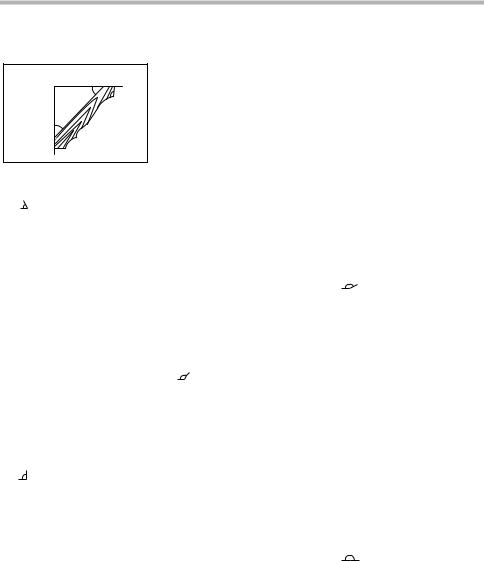
|
EN0003-1 Compound Miter Saw |
000032 |
Miter and Bevel Angle Settings |
Ceiling
45˚
Wall
45˚
Wall to Crown Molding Angle: 45 degrees
Wall Angle |
Bevel Angle |
Miter Angle |
|
Wall Angle |
Bevel Angle |
Miter Angle |
|
Wall Angle |
Bevel Angle |
Miter Angle |
(deg.) |
(deg.) |
(deg.) |
|
(deg.) |
(deg.) |
(deg.) |
|
(deg.) |
(deg.) |
(deg.) |
60 |
37.8 |
50.8 |
|
101 |
26.7 |
30.2 |
|
141 |
13.7 |
14.1 |
61 |
37.5 |
50.2 |
|
102 |
26.4 |
29.8 |
|
142 |
13.3 |
13.7 |
62 |
37.3 |
49.6 |
|
103 |
26.1 |
29.4 |
|
143 |
13.0 |
13.3 |
63 |
37.1 |
49.1 |
|
104 |
25.8 |
28.9 |
|
144 |
12.6 |
12.9 |
64 |
36.8 |
48.5 |
|
105 |
25.5 |
28.5 |
|
145 |
12.3 |
12.6 |
65 |
36.6 |
48.0 |
|
106 |
25.2 |
28.1 |
|
146 |
11.9 |
12.2 |
66 |
36.4 |
47.4 |
|
107 |
24.9 |
27.6 |
|
147 |
11.6 |
11.8 |
67 |
36.1 |
46.9 |
|
108 |
24.6 |
27.2 |
|
148 |
11.2 |
11.5 |
68 |
35.9 |
46.4 |
|
109 |
24.2 |
26.8 |
|
149 |
10.9 |
11.1 |
69 |
35.6 |
45.8 |
|
110 |
23.9 |
26.3 |
|
150 |
10.5 |
10.7 |
70 |
35.4 |
45.3 |
|
111 |
23.6 |
25.9 |
|
151 |
10.2 |
10.4 |
71 |
35.1 |
44.8 |
|
112 |
23.3 |
25.5 |
|
152 |
9.8 |
10.0 |
72 |
34.9 |
44.2 |
|
113 |
23.0 |
25.1 |
|
153 |
9.5 |
9.6 |
73 |
34.6 |
43.7 |
|
114 |
22.7 |
24.7 |
|
154 |
9.2 |
9.3 |
74 |
34.4 |
43.2 |
|
115 |
22.3 |
24.3 |
|
155 |
8.8 |
8.9 |
75 |
34.1 |
42.7 |
|
116 |
22.0 |
23.8 |
|
156 |
8.5 |
8.5 |
76 |
33.9 |
42.1 |
|
117 |
21.7 |
23.4 |
|
157 |
8.1 |
8.2 |
77 |
33.6 |
41.6 |
|
118 |
21.4 |
23.0 |
|
158 |
7.8 |
7.8 |
78 |
33.3 |
41.1 |
|
119 |
21.0 |
22.6 |
|
159 |
7.4 |
7.5 |
79 |
33.1 |
40.6 |
|
120 |
20.7 |
22.2 |
|
160 |
7.1 |
7.1 |
|
|
|
|
|
|
|
|
|
|
|
80 |
32.8 |
40.1 |
|
121 |
20.4 |
21.8 |
|
161 |
6.7 |
6.7 |
81 |
32.5 |
39.6 |
|
122 |
20.0 |
21.4 |
|
162 |
6.4 |
6.4 |
82 |
32.3 |
39.1 |
|
123 |
19.7 |
21.0 |
|
163 |
6.0 |
6.0 |
83 |
32.0 |
38.6 |
|
124 |
19.4 |
20.6 |
|
164 |
5.6 |
5.7 |
84 |
31.7 |
38.1 |
|
125 |
19.1 |
20.2 |
|
165 |
5.3 |
5.3 |
85 |
31.4 |
37.7 |
|
126 |
18.7 |
19.8 |
|
166 |
4.9 |
5.0 |
86 |
31.1 |
37.2 |
|
127 |
18.4 |
19.4 |
|
167 |
4.6 |
4.6 |
87 |
30.9 |
36.7 |
|
128 |
18.1 |
19.0 |
|
168 |
4.2 |
4.3 |
88 |
30.6 |
36.2 |
|
129 |
17.7 |
18.6 |
|
169 |
3.9 |
3.9 |
89 |
30.3 |
35.7 |
|
130 |
17.4 |
18.2 |
|
170 |
3.5 |
3.5 |
90 |
30.0 |
35.3 |
|
131 |
17.1 |
17.9 |
|
171 |
3.2 |
3.2 |
|
|
|
|
|
|
|
|
|
|
|
91 |
29.7 |
34.8 |
|
132 |
16.7 |
17.5 |
|
172 |
2.8 |
2.8 |
92 |
29.4 |
34.3 |
|
133 |
16.4 |
17.1 |
|
173 |
2.5 |
2.5 |
93 |
29.1 |
33.9 |
|
134 |
16.0 |
16.7 |
|
174 |
2.1 |
2.1 |
94 |
28.8 |
33.4 |
|
135 |
15.7 |
16.3 |
|
175 |
1.8 |
1.8 |
95 |
28.5 |
32.9 |
|
136 |
15.4 |
15.9 |
|
176 |
1.4 |
1.4 |
96 |
28.2 |
32.5 |
|
137 |
15.0 |
15.6 |
|
177 |
1.1 |
1.1 |
97 |
27.9 |
32.0 |
|
138 |
14.7 |
15.2 |
|
178 |
0.7 |
7.0 |
98 |
27.6 |
31.6 |
|
139 |
14.3 |
14.8 |
|
179 |
0.4 |
0.4 |
99 |
27.3 |
31.1 |
|
140 |
14.0 |
14.4 |
|
180 |
0.0 |
0.0 |
100 |
27.0 |
30.7 |
|
|
|
|
|
|
|
|
17
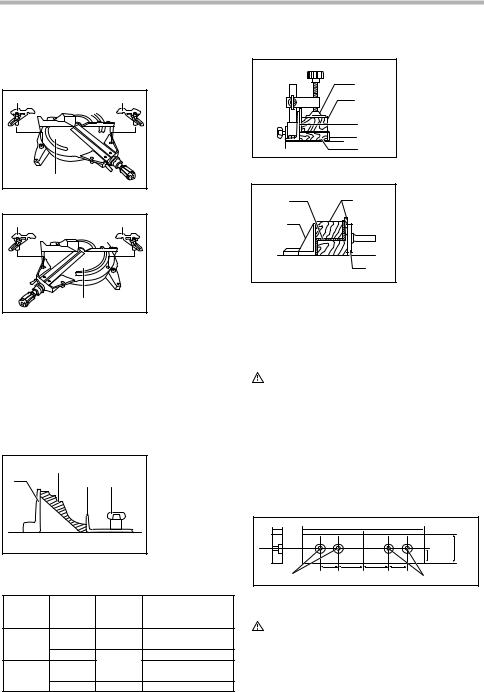
Crown |
molding |
stoppers |
(optional accessories) |
7. |
Cutting aluminum extrusion |
|
|
|
|||||
allow easier cuts of crown molding without tilting the |
|
|
|
|
|
001844 |
|
|
|
||||
saw blade. Install them on the turn base as shown |
|
|
|
|
|
|
1. Vise |
|
|||||
in the figures. |
001558 |
|
|
|
|
1 |
|
2. Spacer block |
|||||
|
|
|
|
|
|
|
3. Guide fence |
||||||
1 |
|
2 |
1. Crown molding |
|
|
|
|
2 |
|
||||
|
|
|
|
|
|
4. Aluminum extru- |
|||||||
|
|
|
stopper L |
|
|
|
|
|
|
|
|
sion |
|
|
|
|
2. Crown molding |
|
|
|
|
|
|
|
|
|
|
|
|
|
|
|
|
|
3 |
|
5. Spacer block |
||||
|
|
|
stopper R |
|
|
|
|
|
|||||
|
|
|
|
|
|
|
4 |
|
|
|
|
|
|
|
|
|
3. Turn base |
|
|
|
|
|
|
|
|
|
|
|
|
|
|
|
|
|
5 |
|
|
|
|
|
|
|
|
|
|
|
|
|
|
|
|
|
|
|
|
3 |
|
|
|
|
|
|
|
004073 |
|
|
|
||
|
|
|
|
|
|
|
|
3 |
|
1. Aluminum extru- |
|||
|
|
001559 |
|
1 |
|
|
|
|
|
sion |
|
||
|
|
|
|
|
|
|
|
2. Guide fence |
|||||
1 |
|
2 |
1. Crown molding |
|
|
|
|
|
|
||||
|
|
2 |
|
|
|
|
3. Spacer blocks |
||||||
|
|
|
stopper L |
|
|
|
|
|
|
4. Horizontal vise |
|||
|
|
|
2. Crown molding |
|
|
|
|
|
|
||||
|
|
|
|
|
|
|
|
|
|
|
(optional acces- |
||
|
|
|
stopper R |
|
|
|
|
|
|
|
|
||
|
|
|
|
|
|
|
|
|
|
|
sory) |
|
|
|
|
|
3. Turn base |
|
|
|
|
|
4 |
|
|
|
|
|
|
|
|
|
|
|
|
|
|
|
|
||
|
3 |
|
|
|
When securing aluminum extrusions, use spacer |
||||||||
|
|
|
|
|
blocks or pieces of scrap as shown in the figure to |
||||||||
Fig. B: At right 45° miter angle |
|
prevent deformation of the aluminum. Use a cutting |
|||||||||||
|
lubricant when cutting the aluminum extrusion to |
||||||||||||
Fig. C: At left 45° miter angle |
|
||||||||||||
|
prevent build-up of the aluminum material on the |
||||||||||||
Position crown molding with its WALL CONTACT |
|
||||||||||||
|
blade. |
|
|
|
|
|
|
|
|
||||
EDGE against the guide fence and its CEILING |
|
|
|
|
|
|
|
|
|
|
|||
CONTACT EDGE against the crown molding stop- |
|
CAUTION: |
|
|
|
|
|
|
|||||
pers as shown in the figure. Adjust the crown mold- |
• |
Never |
attempt |
to cut |
thick or |
|
round |
aluminum |
|||||
ing stoppers according to |
the size of the crown |
|
|||||||||||
|
extrusions. Thick aluminum extrusions may come |
||||||||||||
molding. Tighten the screws to secure the crown |
|
||||||||||||
|
loose |
during |
operation |
and |
round |
aluminum |
|||||||
molding |
stoppers. Refer to |
the table (C) for the |
|
||||||||||
|
extrusions cannot be secured firmly with this tool. |
||||||||||||
miter angle. Use the sub-fence R to secure the |
|
||||||||||||
8. |
Wood facing |
|
|
|
|
|
|
||||||
crown molding more firmly. |
|
|
|
|
|
|
|
||||||
|
|
001560 |
|
Use of wood facing helps to assure splinter-free |
|||||||||
|
2 |
|
1. Guide fence |
|
cuts in workpieces. Attach a wood facing to the |
||||||||
|
|
2. Crown molding |
|
guide fence using the holes in the guide fence and |
|||||||||
|
|
|
|
||||||||||
1 |
3 |
4 |
|
6 mm (1/4”) screws. |
|
|
|
|
|
||||
3. Crown molding |
|
|
|
|
|
|
|||||||
|
|
|
|
See the figure concerning the dimensions for a sug- |
|||||||||
|
|
|
stopper |
|
|||||||||
|
|
|
|
gested wood facing. |
|
|
|
|
|
||||
|
|
|
4. Screw |
|
|
|
|
|
|
||||
|
|
|
|
|
|
|
|
|
|
|
|
005233 |
|
|
|
|
|
|
|
|
|
|
|
|
|
|
|
|
|
|
|
Over 15mm(9/16”) |
Over 540mm(21-1/4”) |
|
|
|
|||||
|
|
|
|
|
1 |
|
72mm |
120mm 120mm |
72mm |
20mm (13/16”) |
115 - 120mm (4-1/2” - 4-3/4”) |
||
|
|
|
006365 |
|
|
1 |
|
||||||
|
|
Table (C) |
|
|
|
|
(2-13/16”) |
(4-3/4”) |
(4-3/4”) |
(2-13/16”) |
|
||
|
|
|
|
|
|
|
|
||||||
|
|
|
1. Hole |
|
|
|
|
|
|
|
|
||
|
|
|
|
|
|
|
|
|
|
|
|
||
Position in |
Miter angle |
Finished piece |
|
|
|
|
|
|
|
|
|
|
|
|
Fig.A |
|
|
|
|
|
|
|
|
|
|
||
|
|
|
|
|
|
|
|
|
|
|
|
|
|
|
|
|
|
|
CAUTION: |
|
|
|
|
|
|
||
For inside |
(1) |
Right 45˚ |
Save the right side of blade |
• |
Use straight wood of even thickness as the wood |
||||||||
corner |
(2) |
|
Save the left side of blade |
|
facing. |
|
|
|
|
|
|
|
|
|
|
|
|
|
|
|
|
|
|
|
|||
|
|
|
|
|
|
|
|
|
|
|
|
||
For outside |
(3) |
Left 45˚ |
Save the right side of blade |
• |
When cutting workpieces from 115 mm (4 -1/2”) to |
||||||||
|
|
120 mm |
(4 - |
3/4”) high, |
use |
a |
wood |
facing to |
|||||
corner |
|
|
|
|
|||||||||
(4) |
Right 45˚ |
Save the left side of blade |
|
prevent a portion of the workpiece near the guide |
|||||||||
|
|
||||||||||||
|
|
|
|
|
fence from being left uncut. |
|
|
|
|
||||
18
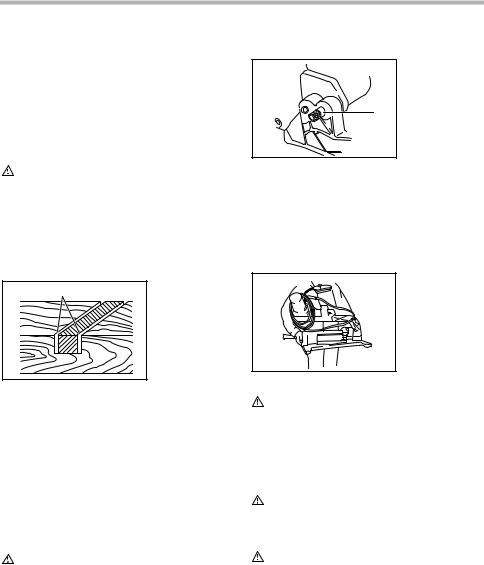
Carrying tool
Example:
When cutting workpieces 120 mm (4 - 3/4”) high, use a wood facing with the following thickness.
|
006475 |
Miter angle |
Thickness of wood facing |
0˚ |
Over 20 mm (13/16") |
Left and Right 45˚ |
Over 15 mm (9/16") |
Right 52˚ |
Over 15 mm (9/16") |
001564
1. Stopper pin
1
CAUTION:
•Use screws to attach the wood facing to the guide fence. The screws should be installed so that the screw heads are below the surface of the wood facing.
•When the wood facing is attached, do not turn the turn base with the handle lowered. The blade and/ or the wood facing will be damaged.
9.Groove cutting
001563 |
1 |
1.Cut grooves with blade
Make sure that the tool is unplugged. Secure the blade at 0° bevel angle and the turn base at right miter angle fully. Secure the slide poles after pulling the carriage toward you fully. Lower the handle fully and lock it in the lowered position by pushing in the stopper pin.
Carry the tool by holding both sides of the tool base as shown in the figure. If you remove the holders, dust bag, etc., you can carry the tool more easily.
002025
A dado type cut can be made by proceeding as follows:
Adjust the lower limit position of the blade using the adjusting screw and the stopper arm to limit the cutting depth of the blade. Refer to “Stopper arm” section described previously.
After adjusting the lower limit position of the blade, cut parallel grooves across the width of the workpiece using a slide (push) cut as shown in the figure. Then remove the workpiece material between the grooves with a chisel. Do not attempt to perform this type of cut using wide (thick) blades or with a dado blade. Possible loss of control and injury may result.
CAUTION:
•Be sure to return the stopper arm to the original position when performing other than groove cutting.
CAUTION:
•Always secure all moving portions before carrying the tool.
•Stopper pin is for carrying and storage purposes only and not for any cutting operations.
MAINTENANCE
CAUTION:
•Always be sure that the tool is switched off and unplugged before attempting to perform inspection or maintenance.
WARNING:
•Always be sure that the blade is sharp and clean for the best and safest performance.
Adjusting the cutting angle
This tool is carefully adjusted and aligned at the factory, but rough handling may have affected the alignment. If your tool is not aligned properly, perform the following:
19
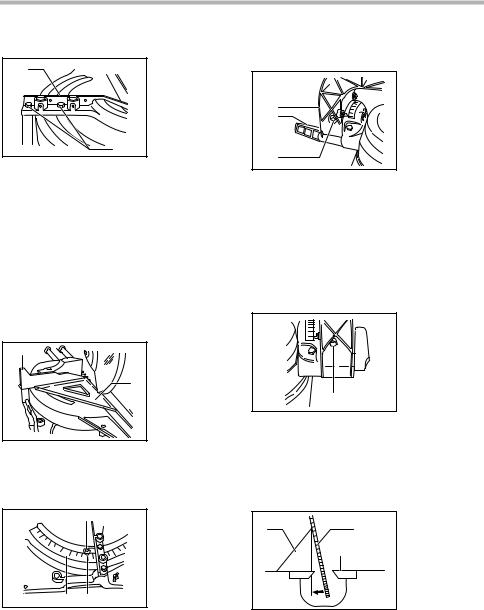
1.Miter angle
001566
1. Guide fence
1
2. Hex bolts
2
Push the carriage toward the guide fence and tighten the knob to secure the carriage.
Loosen the grip which secures the turn base. Turn the turn base so that the pointer points to 0° on the miter scale. Then turn the turn base slightly clockwise and counterclockwise to seat the turn base in the 0° miter notch. (Leave as it is if the pointer does not point to 0°.) Loosen the hex bolts securing the guide fence using the socket wrench.
Lower the handle fully and lock it in the lowered position by pushing in the stopper pin. Square the side of the blade with the face of the guide fence using a triangular rule, try-square, etc. Then securely tighten the hex bolts on the guide fence in the order from the right side.
001567 |
1 |
2 |
1.Guide fence
2.Triangular rule
Make sure that the pointer points to 0° on the miter scale. If the pointer does not point to 0°, loosen the screw which secures the pointer and adjust the pointer so that it will point to 0°.
|
001568 |
|
1 |
1. |
Screw |
|
2. |
Miter scale |
|
3. |
Pointer |
2 3
2.Bevel angle
(1)0° bevel angle
|
001569 |
|
|
1. |
Arm |
|
2. |
Lever |
1 |
3. |
Hex bolt |
|
|
|
2 |
|
|
3
Push the carriage toward the guide fence and tighten the knob to secure the carriage. Lower the handle fully and lock it in the lowered position by pushing in the stopper pin. Loosen the lever at the rear of the tool. Make sure that the arm is locked.
Turn the hex bolt on the left side of the arm two or three revolutions counterclockwise. Turn the hex bolt on the right side of the arm two or three revolutions counterclockwise to tilt the blade to the left.
001570
1. Hex bolt
1
Carefully square the side of the blade with the top surface of the turn base using the triangular rule, try-square, etc. by turning the hex bolt on the right side of the arm clockwise. Turn the hex bolt on the left side of the arm clockwise as far as it will go. Then tighten the lever securely.
|
001571 |
1 |
2 |
|
3 |
1.Triangular rule
2.Saw blade
3.Top surface of turn base
Make sure that the two pointers on the arm point to each 0° on the bevel scale on the arm holder. If they do not point to 0°, loosen the screws which secure the pointers and adjust them so that they will point to 0°.
20
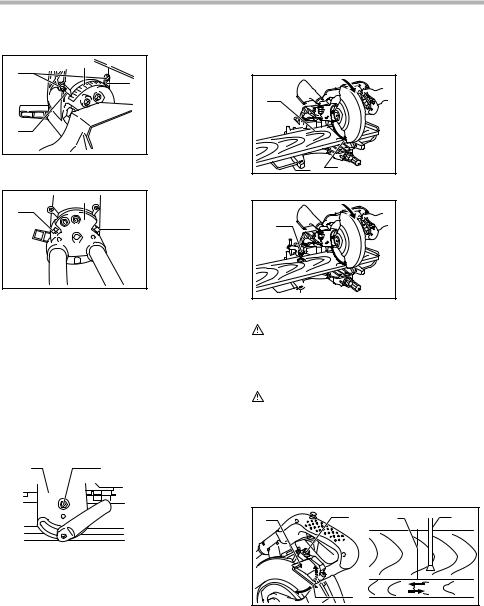
|
001572 |
|
1 |
2 |
3 |
|
|
3 |
|
(2) |
45° bevel angle |
|
001573 |
|
1 |
2 |
|
|
3 |
1.Bevel scale
2.Screws
3.Pointers
1.Arm holder
2.Right 45° bevel angle adjusting bolt
3.Left 45° bevel angle adjusting bolt
Adjust the 45° bevel angle only after performing 0° bevel angle adjustment. To adjust left 45° bevel angle, loosen the lever and tilt the blade to the left fully. Make sure that the pointer on the arm points to 45° on the bevel scale on the arm holder. If the pointer does not point to 45°, turn the left 45° bevel angle adjusting bolt on the side of the arm holder until the pointer points to 45°.
To adjust right 45° bevel angle, perform the same procedure described above.
Adjusting for smooth beveling action
|
|
004860 |
|
|
1 |
2 |
|
1. |
Arm |
|
2. |
Hex lock nut |
||
|
|
|
|
|
The hex lock nut holding together the arm and arm holder has been factory adjusted to assure smooth beveling action and to guarantee precise cutting. Do not tamper with it. Should looseness develop at the arm and arm holder connection, tighten the hex lock nut using a wrench.
Adjusting the position of laser line
For model LS1214L only
|
006342 |
1 |
|
3 |
2 |
|
006343 |
1 |
|
 2
2
1.Workpiece
2.Cutting line
3.Holder
1.Vertical vise
2.Holder
WARNING:
•As the tool is plugged when adjusting the position of laser line, take a full caution especially at switch action. Pulling the switch trigger accidentally cause an accidental start of the tool and personal injury.
CAUTION:
•LASER RADIATION Do not stare into beam.
•Never apply a blow or impact to the tool. A blow or impact causes the incorrect position of laser line, damage to the laser beam emitting part or a short life of the tool.
When adjusting the laser line appears on the left side of the saw blade
|
|
|
006345 |
1 |
2 |
4 |
5 |
|
|
|
|
|
3 |
|
|
1. |
Screw to change the |
2. |
Adjusting screw |
|
movable range of the |
|
|
|
adjusting screw |
|
|
3. |
Hex Wrench |
4. |
Laser line |
5. |
Saw blade |
|
|
21
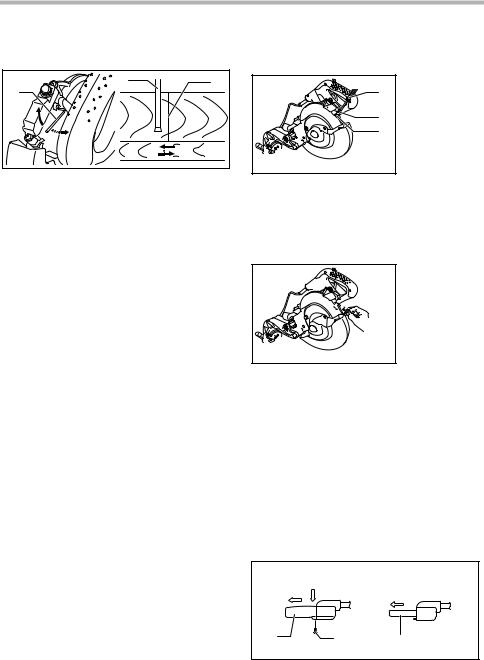
When adjusting the laser line appears on the right side of the saw blade
|
006344 |
2 |
3 |
1 |
|
1. |
Screw to change the |
2. Saw blade |
|
movable range of the |
|
|
adjusting screw |
|
3. |
Laser line |
|
For both adjustments, do as follows.
1.Make sure that the tool is unplugged.
2.Draw the cutting line on the workpiece and place it on the turn table. At this time, do not secure the workpiece with a vise or similar securing device.
3.Lower the blade by lowering the handle and just check to see where the cutting line and the position of the saw blade is. (Decide which position to cut on the line of cut.)
4.After decision the position to be cut, return the handle to the original position. Secure the workpiece with the vertical vise without shifting the workpiece from the pre-checked position.
5.Plug the tool and turn on the laser switch.
6.Adjust the position of laser line as follows.
The position of laser line can be changed as the movable range of the adjusting screw for the laser is changed by turning two screws with a hex wrench. (The movable range of laser line is factory adjusted within 1 mm (0.04”) from the side surface of blade.)
To shift the laser line movable range further away from the side surface of blade, turn the two screws counterclockwise after loosening the adjusting screw. Turn these two screws clockwise to shift it closer to the side surface of the blade after loosening the adjusting screw.
Refer to the section titled “Laser line action” and adjust the adjusting screw so that the cutting line on your workpiece is aligned with the laser line.
NOTE:
•Check the position of laser line regularly for accuracy.
•Have the tool repaired by Makita authorized service center for any failure on the laser unit.
Cleaning of the lens for the laser light
For model LS1214L only
006346 |
1 |
2 |
3 |
1.Screwdriver
2.Screw (one piece only)
3.Lens for the laser light
If the lens for the laser light becomes dirty, or sawdust adheres to it in such a way that the laser line is no longer easily visible, unplug the saw and remove and clean the lens for the laser light carefully with a damp, soft cloth. Do not use solvents or any petroleum-based cleaners on the lens.
006347
1. Lens for the

 laser light
laser light 

 1
1
To remove the lens for the laser light, remove the saw blade before removing the lens according to the instructions in the section titled “Installing or removing saw blade”.
Loosen but do not remove the screw which secures the lens using a screwdriver.
Pull out the lens as shown in the figure.
NOTE:
•If the lens does not come out, loosen the screw further and pull out the lens again without removing the screw.
Replacing fluorescent tube
For LS1214F only
002028
|
1 |
2 |
|
1 |
|
|
|
|
|
|
3 |
|
4 |
5 |
|
|
|
|
|
1. |
Pull out |
|
2. |
Push |
3. |
Lamp box |
|
4. |
Screws |
5. |
Fluorescent tube |
|
|
|
22
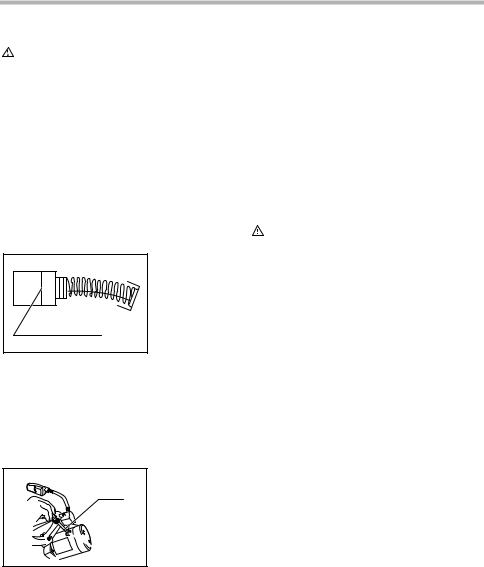
CAUTION:
•Always be sure that the tool is switched off and unplugged before replacing the fluorescent tube.
•Do not apply force, impact or scratch to a fluorescent tube, which can cause a glass of the fluorescent tube to be broken resulting in a injury to you or your bystanders.
•Leave the florescent tube for a while immediately after a use of it and then replace it. If not. You may burn yourself.
Remove screws, which secure Lamp Box for the light.
Pull out the Lamp Box keeping pushing lightly the upper position of it as illustrated on the left.
Pull out the fluorescent tube and then replace it with Makita original new one.
Replacing carbon brushes
001145
1. Limit mark
1
Remove and check the carbon brushes regularly. Replace when they wear down to the limit mark. Keep the carbon brushes clean and free to slip in the holders. Both carbon brushes should be replaced at the same time. Use only identical carbon brushes.
Use a screwdriver to remove the brush holder caps. Take out the worn carbon brushes, insert the new ones and secure the brush holder caps.
002463
1. Brush holder cap
2 2. Screwdriver
 1
1
After replacing brushes, plug in the tool and break in brushes by running tool with no load for about 10 minutes. Then check the tool while running and electric brake operation when releasing the switch trigger. If electric brake is not working well, ask your local Makita service center for repair.
After use
•After use, wipe off chips and dust adhering to the tool with a cloth or the like. Keep the blade guard clean according to the directions in the previously covered section titled “Blade guard”. Lubricate the sliding portions with machine oil to prevent rust.
•When storing the tool, pull the carriage toward you fully so that the slide pole is thoroughly inserted into the turn base.
To maintain product SAFETY and RELIABILITY, repairs, any other maintenance or adjustment should be performed by Makita Authorized or Factory Service Centers, always using Makita replacement parts.
ACCESSORIES
CAUTION:
•These accessories or attachments are recommended for use with your Makita tool specified in this manual. The use of any other accessories or attachments might present a risk of injury to persons. Only use accessory or attachment for its stated purpose.
If you need any assistance for more details regarding these accessories, ask your local Makita service center.
•Steel & Carbide-tipped saw blades
|
006526 |
|
Miter saw blades |
For smooth and precise cutting in various materials. |
|
|
|
|
Combination |
General purpose blade for fast and smooth rip, |
|
crosscuts and miters. |
||
|
||
|
|
|
Crosscutting |
For smoother cross grain cuts. Slices cleanly |
|
against the grain. |
||
|
||
|
|
|
Fine cross cuts |
For sand-free cuts cleanly against the grain. |
|
|
|
|
Non-ferrous metals |
For miters in aluminum, copper, brass, tubing, |
|
miter saw blades |
and other non-ferrous metals. |
|
|
|
•Sub-fence R
•Vise assembly (Horizontal vise)
•Vertical vise
•Socket wrench 13
•Holder
•Dust bag
•Elbow
•Crown molding stopper set
•Triangular rule
•Lock-off button (2 pcs.)
•Fluorescent tube (For LS1214F)
•Hex wrench (For LS1214L)
23
